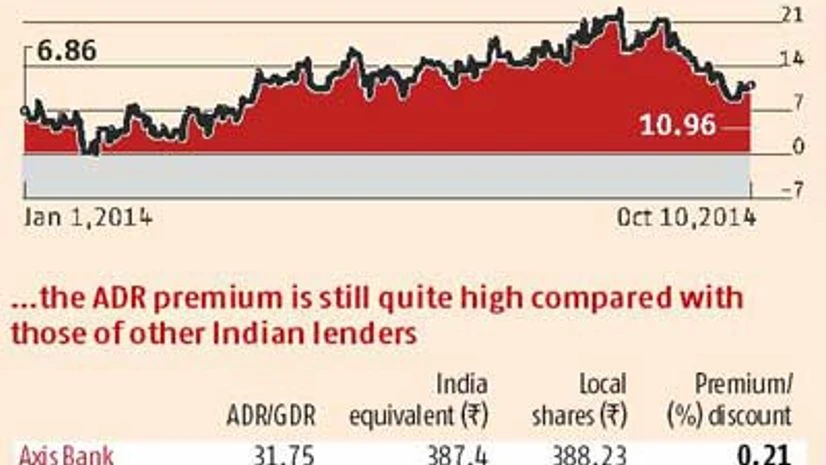Foreign investors are anticipating a long-pending nod from the Foreign Investment Promotion Board (FIPB) for an increase in foreign investment limit in HDFC Bank, going by the recent narrowing in premiums.
The premium between HDFC Bank's American Depositary Receipts (ADRs) and its local shares have seen a sharp reduction in the past month.
The closing value of New York Stock Exchange-listed ADRs on Friday was Rs 962 (after conversion), about 11 per cent more than the rupee value of shares traded on Indian bourses. In September, the premium had shot up to as much as 21 per cent as foreign investors were forced to increase their bets on HDFC Bank through these instruments. The rupee has also weakened against the dollar in the past month, though the depreciation has been less than two per cent.
"The reduction in premium suggests investors expect the foreign investment limit issue to be resolved soon. In the absence of enough leg room, foreign investors were betting on the HDFC Bank stock, either through the ADR route or through the derivatives market," said a fund manager, who didn't wish to be named.
The country's largest private sector lender in terms of market value, HDFC Bank's proposal seeking a higher foreign investment limit is likely to be taken up by FIPB, the inter-ministerial agency for approving foreign investment proposals, on October 21. The lender has asked for an enhancement in foreign ownership from the present 51 per cent to 67.55 per cent. This is excluding the stake held by Housing Development Finance Corporation (HDFC), the treatment of which also has become a bone of contention, as the foreign institutional investor (FII) holding in it has touched nearly 78 per cent.
Though the premium on HDFC ADRs has come off, it is still higher compared to some of the other lenders whose depository receipts (DRs) are traded abroad. For instance, the difference between ICICI Bank ADRs and local shares is only three per cent. The DRs of lenders listed elsewhere, including Axis Bank, Kotak Mahindra Bank and State Bank of India, trade almost at par with their local shares.
Market players suggest the activity in the HDFC Bank counter in the derivatives segment and also in the FII-to-FII trading segment has been seen cooling off in recent months.
"Once the FIPB nod is in place, shares of HDFC Bank and the ADRs should converge," said the fund manager. The FIPB meeting also comes at a time when the bank has prepared equity capital raising plans of up to Rs 10,000 crore. Analysts believe the FII investment issue could act as a tailwind for the HDFC Bank stock.
"The price impact of the restrictions is acute in the very short term. Long term, we detect some under-performance. The ADR premia of HDFC Bank and ICICI Bank also point to the problems being material, as does the one to seven per cent FII premia the stocks trade on. Our view is that FII restrictions are a significant tailwind to stock performance," said a September report by JPMorgan.
Restrictions on FII ownership have led global index provider MSCI to lower HDFC Bank's weightage in its key indices, which has weighed on the stock performance. "If the larger stocks come out of FII restriction, the impact on the sector's MSCI weightage could be significant. This could trigger large passive inflows, creating a strong incentive for the government to resolve the issues," said the JPMorgan report.
The restriction on FII ownership, though, has helped the performance of the ADRs. Those of HDFC Bank, traded in New York, are up 37 per cent so far this year, compared to a gain of 30 per cent in local shares traded on BSE and the NSE. India's benchmark Sensex index is up 24 per cent so far in 2014.

)
